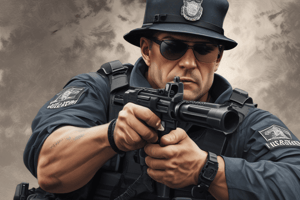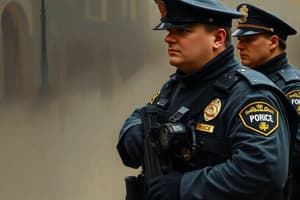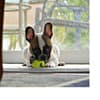Podcast
Questions and Answers
Which department offers federal financial assistance to scholars, practitioners, experts, and state and local governments and agencies?
Which department offers federal financial assistance to scholars, practitioners, experts, and state and local governments and agencies?
- Office of Violence Against Women (OVW)
- Community Oriented Policing Services Office (COPS)
- Department of Justice
- Office of Justice Programs (OJP) (correct)
Which office administers 19 grant programs to help assist victims of domestic violence, sexual assault, date rape, and stalking?
Which office administers 19 grant programs to help assist victims of domestic violence, sexual assault, date rape, and stalking?
- Office on Violence Against Women (OVW) (correct)
- Office of Justice Programs (OJP)
- Community Oriented Policing Services Office (COPS)
- Department of Justice
What was the basis for distributing federal grant money to each department for drug control, as mentioned in the text?
What was the basis for distributing federal grant money to each department for drug control, as mentioned in the text?
- Percentage reduction in drug-related crimes
- Amount of drugs seized
- Number of drug arrests (correct)
- Number of drug-related incidents reported
What did Balko overlook regarding the increase in drug arrests in one county?
What did Balko overlook regarding the increase in drug arrests in one county?
What was the catalyst for the FBI to mandate all agents be armed with semi-automatic handguns chambered for larger caliber rounds?
What was the catalyst for the FBI to mandate all agents be armed with semi-automatic handguns chambered for larger caliber rounds?
What led to the adoption of semi-automatic rifles and submachine guns by some police departments?
What led to the adoption of semi-automatic rifles and submachine guns by some police departments?
What is the useful range of a shotgun with slugs?
What is the useful range of a shotgun with slugs?
In a shootout with heavily armed suspects, what is considered the best weapon?
In a shootout with heavily armed suspects, what is considered the best weapon?
What was the main reason for the adoption of semi-automatic rifles and submachine guns by some police departments?
What was the main reason for the adoption of semi-automatic rifles and submachine guns by some police departments?
What incident involved two FBI agents killed while using .38 caliber revolvers against suspects armed with Mini-14 rifles?
What incident involved two FBI agents killed while using .38 caliber revolvers against suspects armed with Mini-14 rifles?
What percentage of law officers killed in 1995 were killed by automatic weapons?
What percentage of law officers killed in 1995 were killed by automatic weapons?
What is the acronym for the Lenco BearCat vehicle?
What is the acronym for the Lenco BearCat vehicle?
What did Congress pass in 1994 to facilitate the transfer of excess military equipment to the police?
What did Congress pass in 1994 to facilitate the transfer of excess military equipment to the police?
What is the purpose of MRAP (Mine-Resistant Ambush Protected) vehicles for the police?
What is the purpose of MRAP (Mine-Resistant Ambush Protected) vehicles for the police?
What did Radley Balko focus on regarding SWAT raids?
What did Radley Balko focus on regarding SWAT raids?
What was the standard price of a Lenco BearCat vehicle for the federal government?
What was the standard price of a Lenco BearCat vehicle for the federal government?
What was the larger version of the Lenco BearCat vehicle called?
What was the larger version of the Lenco BearCat vehicle called?
What did police departments realize they needed after the North Hollywood shootout?
What did police departments realize they needed after the North Hollywood shootout?
What did critics claim MRAPs are proof of?
What did critics claim MRAPs are proof of?
What did Radley Balko ignore according to police administrators?
What did Radley Balko ignore according to police administrators?
What was one concern raised by Radley Balko regarding federal funding to police?
What was one concern raised by Radley Balko regarding federal funding to police?
How many civilians were killed by American police officers in New York City in 2010?
How many civilians were killed by American police officers in New York City in 2010?
What percentage of the New York City Police Department's shootings occurred within ten feet of the subject in 2010?
What percentage of the New York City Police Department's shootings occurred within ten feet of the subject in 2010?
How many grants were awarded by the Edward Byrne Memorial Assistance Program in fiscal year 2016?
How many grants were awarded by the Edward Byrne Memorial Assistance Program in fiscal year 2016?
What percentage of the population in New York City did Blacks and Hispanics represent in 2010?
What percentage of the population in New York City did Blacks and Hispanics represent in 2010?
How many officers discharged their weapons during adversarial conflicts in New York City in 2010?
How many officers discharged their weapons during adversarial conflicts in New York City in 2010?
How many citizen-upon-citizen criminal shooting incidents were there in New York City in 2010?
How many citizen-upon-citizen criminal shooting incidents were there in New York City in 2010?
What was the total amount of grants awarded by the Edward Byrne Memorial Assistance Program in 2012?
What was the total amount of grants awarded by the Edward Byrne Memorial Assistance Program in 2012?
How many contacts with civilians did the New York City Police Department have in 2010?
How many contacts with civilians did the New York City Police Department have in 2010?
How many people were arrested for gun possession out of those using, displaying or possessing a weapon in New York City in 2010?
How many people were arrested for gun possession out of those using, displaying or possessing a weapon in New York City in 2010?
What percentage of civilians involved in adversarial shootings were black in New York City in 2010?
What percentage of civilians involved in adversarial shootings were black in New York City in 2010?
What is the percentage of calls for service that involved weapons out of approximately 4.5 million calls for service received by the New York City Police Department in 2010?
What is the percentage of calls for service that involved weapons out of approximately 4.5 million calls for service received by the New York City Police Department in 2010?
What is the percentage of law enforcement agencies' shootings that occurred within ten feet of the subject according to the data from the New York City Police Department's Annual Firearms Discharge Report for 2010?
What is the percentage of law enforcement agencies' shootings that occurred within ten feet of the subject according to the data from the New York City Police Department's Annual Firearms Discharge Report for 2010?
What was the total number of adversarial shooting incidents involving civilians and police officers in New York City according to data from the Annual Firearms Discharge Report for 2010?
What was the total number of adversarial shooting incidents involving civilians and police officers in New York City according to data from the Annual Firearms Discharge Report for 2010?
Study Notes
-
Until the 1960s, most U.S. police officers carried six-round .38 special handguns for their sidearms.
-
From the late 1960s to the late 1990s, most police departments issued shotguns to their officers, often stored in the trunks of squad cars.
-
In the 1980s, an incident involving FBI agents and bank robbers led to the questioning of the utility of .38 caliber revolvers.
-
In the April 11, 1986 incident, two FBI agents were killed while using .38 caliber revolvers against suspects armed with Mini-14 rifles.
-
The subsequent FBI investigation attributed the agents' deaths in part to the lack of stopping power of the .38 caliber rounds and the difficulty of reloading revolvers under fire.
-
In response, the FBI mandated that all agents be armed with semi-automatic handguns chambered for larger caliber rounds.
-
In the late 1990s, an incident in North Hollywood, California, involving heavily armed bank robbers and the Los Angeles Police Department, led to the adoption of semi-automatic rifles and submachine guns by some police departments.
-
The North Hollywood shootout on February 28, 1997, saw the robbers firing over 200 rounds and wearing body armor, making standard police weapons ineffective.
-
The robbers, Larry Phillips, Jr. and Emil Matasareanu, were eventually killed after an extended shootout, leaving 11 police officers and 7 civilians wounded and nearly 2,000 rounds fired.
-
The inability of standard police weapons to penetrate the robbers' body armor led to the adoption of semi-automatic rifles and submachine guns by some departments for use against heavily armed suspects.
-
The Heckler and Koch MP5, a 9mm submachine gun, became the most popular choice for many departments due to its light weight, air cooling, and magazine capacity.
-
Shotguns have a range of 30 yards with buckshot and 50-100 yards with slugs, pistols are useful only within 25 yards, and semi-automatic rifles or submachine guns have a useful range of about 50 yards.
-
In a shootout with heavily armed suspects, the best weapon is a .223 caliber rifle, which is accurate to over 100 yards.
-
The Community Oriented Policing Services Office (COPS) offers grants to help law enforcement agencies hire community policing officers, acquire new technologies and equipment, hire civilians for administrative tasks, and promote innovative approaches to solving crime.
-
In 2012, the Office of Justice Programs solicited grant proposals for various programs, including drug courts, violence reduction, and policing.
-
The policing grants are awarded from the Edward Byrne Memorial Assistance Program. In 2012, the program awarded 1,128 grants, totaling $93,677,129. In fiscal year 2016, the program awarded 1,011 grants, totaling $84,348,558.
-
In 2010, the New York City Police Department had approximately 34,565 officers and over 23,000,000 contacts with civilians. Of these contacts, 206,874 involved a weapon. There were 28,880 people using, displaying, or possessing a weapon who were arrested. Of these, 6,021 were for gun possession.
-
In 2010, there were 1,473 citizen-upon-citizen criminal shooting incidents. However, only 52 officers intentionally fired their weapons at another person during an "adversarial conflict." These incidents resulted in eight civilian deaths and 16 injuries.
-
Of the 33 shooting incidents in 2010, 56% of civilians involved were black, 26% were Hispanic, 15% were white, and 6% were Asian. Blacks and Hispanics represented 52% of the population in the city.
-
In 2010, 65% of New York City Police Department's shootings occurred within ten feet of the subject. Of 334 civilians involved in adversarial shootings, 56% were black.
-
The New York City Police Department responded to approximately 4.5 million calls for service in 2010. Of these, 206,874 involved weapons, and 52 officers discharged their weapons. This represents .15% of all calls, indicating that the police department acted with restraint.
-
Police departments are sometimes criticized for being "little armies" at war with their citizens, leading to excessive use of force. However, data from the New York City Police Department's Annual Firearms Discharge Report for 2010 shows that only a small percentage of officers discharge their weapons during adversarial conflicts.
-
Some critics have claimed that police officers carry M4 and M16 rifles on patrol, but this is not true. Police firearms have evolved over time, and officers carry various types of firearms for different situations.
Studying That Suits You
Use AI to generate personalized quizzes and flashcards to suit your learning preferences.
Description
Explore the historical weapons carried by U.S. police officers, from six-round .38 special handguns to the issuance of shotguns. Learn about the storage methods and emergency protocols for these firearms.





